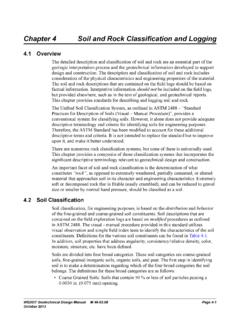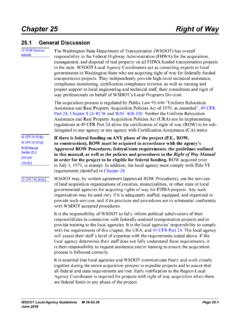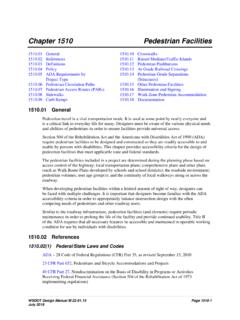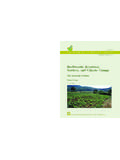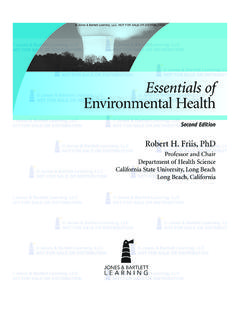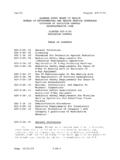Transcription of Chapter 1610 Traffic Barriers
1 WSDOT Design Manual M Page 1610-1 July 2017 Chapter 1610 Traffic Barriers Introduction Barrier Impacts General Barrier Design Considerations Beam Guardrail High-Tension Cable Barrier Concrete Barrier Bridge Traffic Barriers Other Barriers References Chapter Organization: The first sections (Introduction and Barrier Impacts) present information to consider when deciding whether to install a barrier. The next section (General Barrier Design Considerations) contains guidance common to ALL barrier types, such as deflection distance, length of need and sight distance. The remaining sections present design information organized by specific barrier type (beam guardrail, cable barrier, etc.). Refer to the Design Manual Glossary for many of the terms used in this Chapter .
2 Refer to Chapter 300 for design documentation requirements. Introduction The Washington State Department of Transportation (WSDOT) uses Traffic Barriers to reduce the overall severity of crashes. Consideration is given as to whether a barrier is preferable to the recovery area it may replace. In some cases, installation of a Traffic barrier may result in more crashes as it presents an object that can be struck. Barriers are designed so that such encounters might be less severe and not lead to secondary or tertiary crashes. However, Traffic Barriers are not guaranteed to redirect an impacting vehicle without resulting injury to its occupants or triggering additional crashes. Barrier performance is affected by the characteristics of the vehicles that collide with them. Different vehicles will react differently given the characteristics and dynamics of the crash.
3 Therefore, vehicles will be decelerated and redirected differently given the size, weight and direction of force imparted from the vehicle to the barrier. Barriers are not placed with the assumption that the system will restrain or redirect all vehicles in all conditions. It is recognized that the designer cannot design a system that will address every potential crash situation. Instead, Barriers are placed with the assumption that, under typical crash conditions, they might decrease the potential for excessive vehicular deceleration or excessive vehicle redirection when compared to the location without the barrier. Traffic Barriers do not prevent crashes or injuries from occurring. They often lower the potential severity for crash outcomes. Consequently, Barriers should not be used unless a reduced crash severity potential is likely.
4 No matter how well a barrier system is designed, optimal performance is dependent on drivers proper maintenance and operation of their vehicles and the proper use of passenger restraint systems. The ultimate choice of barrier type and placement should be made by gaining an understanding of site and Traffic conditions, having a thorough understanding of and applying the criteria presented in Chapters 1600 and 1610, and using engineering judgment. Traffic Barriers Chapter 1610 Page 1610-2 WSDOT Design Manual M July 2017 Barrier systems and vehicle fleets continue to evolve. The choice of a barrier is based on the characteristics of today s vehicle fleet and testing criteria, not on speculative assumptions of future vehicle designs. This continuum of change does not allow engineers to predict the future with any degree of certainty.
5 Consequently, engineering decisions need to be made based on the most reliable and current information. Engineers are constantly striving to develop more effective design features to improve highway safety. However, economics, asset management and maintenance needs, and feasibility do not permit the deployment of new designs as soon as they become available on the market or are invented by a manufacturer. Further, most new designs only make marginal changes to systems and do not imply that old designs are unsafe or need modification. Solutions may consider crash frequency and severity. As discussed previously, performance of the system relies on the interaction of the vehicle, driver, and system design at any given location. Additionally, the ability to safely access, maintain and operate over time is incorporated into the final barrier decision.
6 When Barriers are crash-tested, it is impossible to replicate the innumerable variations in highway conditions under which the barrier applications occur. Therefore, Barriers are crash-tested under standardized conditions. These standard conditions were previously documented in National Cooperative Highway Research Program (NCHRP) Reports 230 and 350. These guidelines have been updated and are now presented in the AASHTO publication, Manual for Assessing Safety Hardware (MASH). As roadside safety hardware changes occur on the highway system they will use MASH crash testing criteria instead of NCHRP Report 350. To learn more about WSDOT s plan for implementing MASH-compliant hardware see the following website: (1) Site Constraints Site constraints play a major role in decisions regarding guardrail selection and placement.
7 Depending on the location, these constraints may include (but are not limited to) environmental considerations, topographic challenges, restricted right-of -way, geologic concerns or conflicts with other infrastructure to name just a few. Document barrier location decisions, including any site constraints encountered that influenced those decisions. A decision to install barrier using criteria outside the guidance provided in this Chapter requires a Design Analysis (See Chapter 300). Barrier Impacts Engineering judgment is required in determining the appropriate placement of barrier systems, therefore consider the location of the system and the possible impacts the barrier may have to other highway objectives. (1) Assessing Impacts to Stormwater and Wetlands The presence of stormwater facilities or wetlands influence the choice and use of barrier systems.
8 For example, the placement of concrete barrier may increase the amount of impervious surface, which could then result in retrofit or reconstruction of the existing retention/detention systems and environmental impact requirements and studies. Assess Chapter 1610 Traffic Barriers WSDOT Design Manual M Page 1610-3 July 2017 whether concrete barrier or beam guardrail placement will cause the need for an evaluation by the HQ Environmental Services Office. Conduct this evaluation early in the project s development process to allow adequate time for discussion of options. (2) Assessing Impacts to Wildlife The placement of concrete Barriers in locations where wildlife frequently cross the highway can influence wildlife-vehicle crash potential. When wildlife encounters physical Barriers that are difficult to see beyond or cross, such as concrete Barriers , they often stop or move parallel to those Barriers , increasing their time on the highway and their exposure.
9 Traffic -related wildlife mortality may play a role in the decline of some species listed under the Endangered Species Act. To address wildlife concerns, see Exhibit 1610-1 to assess whether barrier placement needs to have an evaluation by the HQ Environmental Services Office to determine its effect on wildlife. Conduct this evaluation early in the project development process to allow adequate time for discussion of options. Exhibit 1610-1 Concrete Barrier Placement Guidance: Assessing Impacts to Wildlife Will the barrier be left within the same milepost limits for greater than 60 days? YES NO NO NO NO YES YES Is the project located entirely within a developed urban area? (Consult Highway Log) Is right of way fenced with 6-foot or higher chain link or wire mesh fence? NO YES YES YES Will the barrier be entirely on an elevated structure (bridge, overpass, viaduct)?
10 NO NO NO Will the barrier be installed adjacent to a stream, river, wetland, lake, or pond? Will the barrier be installed in a WSDOT-identified highway segment with a high or medium rank for wildlife-related safety or ecological stewardship (information available on WSDOT Environmental Workbench under Habitat Connectivity), or in a section of highway posted with wildlife warning signs? Will the barrier be installed on or adjacent to lands administered by a federal or state agency or an American Indian Tribe or private conservation organization? YES Does the project propose to use a concrete barrier? Contact the Region or HQ Environmental Services Office for Assistance in Determining the Effect of Barrier Placement No Contact Necessary YES Traffic Barriers Chapter 1610 Page 1610-4 WSDOT Design Manual M July 2017 General Barrier Design Considerations See Chapter 1105 Design Element Selection for guidance regarding required design elements for the various different project types (programs and subprograms).


